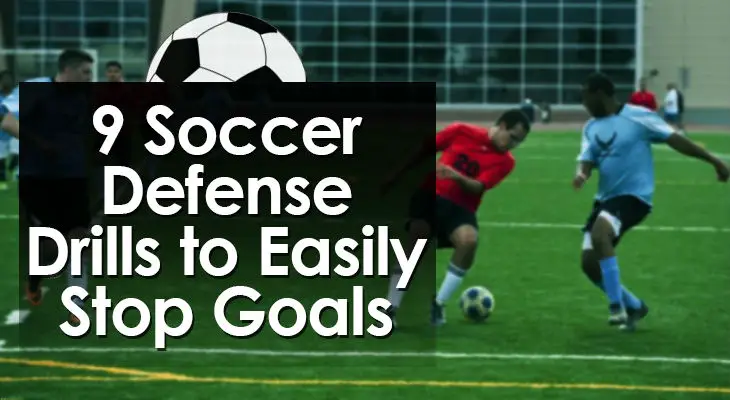11 Soccer Defense Drills (2024 Update)
Defense. Defense. Defense.
Here's something a lot of soccer coaches forget:
You might have the best strikers in the league -- but if you can't stop the opposition from scoring, you're going to lose.
Developing a strong defensive team starts with using challenging and effective soccer defense drills during your training sessions.
And a strong defensive team is imperative if you're aiming for your team and players to have any short-term or long-term success.
Below are 9 detailed soccer defense drills I highly recommend...
11 Soccer Defense Drills
1. 2-on-2 Support
How the Drill Works:
Two defenders pass the ball out to two attackers and attempt to prevent them from scoring on goal. One defender runs directly to the attacker receiving the pass while the second defender supports and is ready to pressure the second attacker if the ball is passed.
Purpose:
Develop individual defending skills as well as defensive supporting positioning. Defenders improve their footwork, timing, and defensive angles. Attackers increase their 1-on-1 dribbling, decision-making, and finishing.
Setup:
- One full-sized goal is needed.
- One goalkeeper is positioned in goal. If there are extra goalkeepers, have them stand to the side of the goal and rotate in every 2-3 repetitions.
- Place two cones 10-15 yards outside of the penalty area. The two cones should line up with the two goalposts. These will be the offensive cones.
- Place two cones 2-3 yards off each goalpost on the end line. These will be the defensive cones.
- Have the players divide evenly between the four cones and form lines behind each cone.
- All the soccer balls should be divided between the two defensive lines on the end line.
- The first player in each defensive line work together. One of these defenders starts with a ball at their feet.
- The first player in each offensive line work together.
- Decide on the number of rounds and time for each round. At least two rounds of 6-8 minutes is suggested.
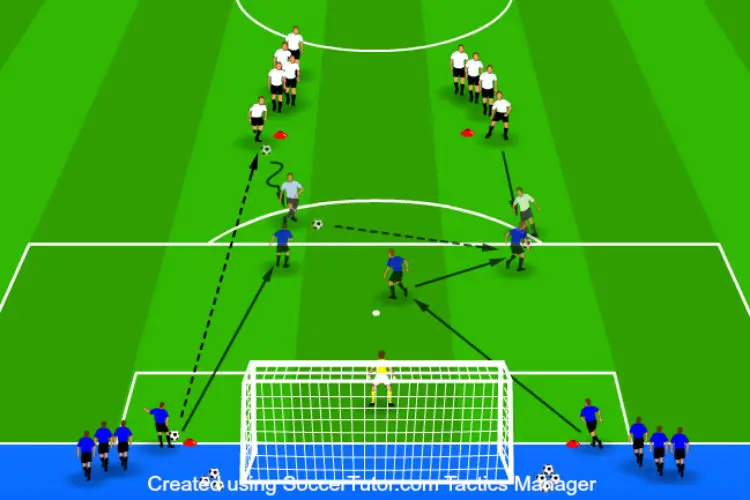
Instructions:
- To start the activity, the defender with the soccer ball passes to one of the two attackers.
- The two defenders sprint towards the attackers with the defender closest to the attacker receiving the pass applying more pressure than the other defender.
- The two attackers attempt to dribble and pass around the defenders to create a shot on goal.
- The defender who is not applying direct pressure to the player on the ball is considered the supporting defender and moves into a position off the main defender’s shoulder. The supporting defender should be in between helping the main defender if they get beat and the second attacker in case a pass is made to them. The supporting defender becomes the main defender and applies pressure if the second attacker receives the ball. The main defender immediately switches and becomes the supporting defender when this happens.
- The turn is over when the defenders win the ball, block the shot, or the attackers score.
- The next four players begin their turn once the players in front of them have finished and cleared the field. Players return to the back of their original lines after their turn.
- Continue this process for the remainder of the round. At the end of the round, gather any lost soccer balls, and switch lines. Defenders become attackers and attackers become defenders.
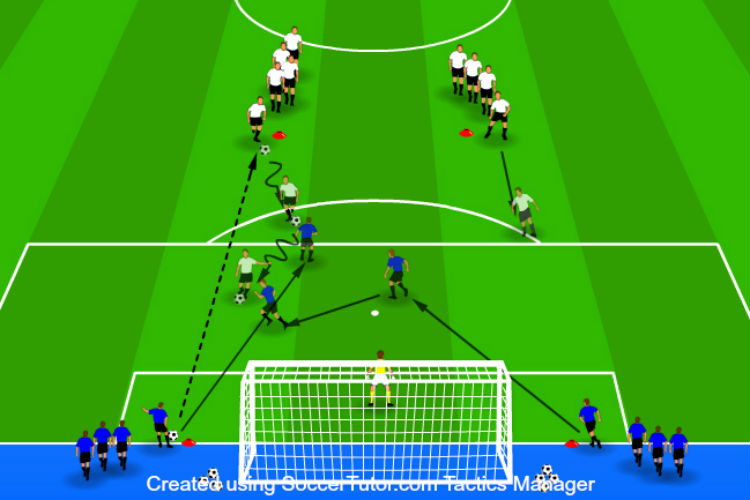
Variations:
2-on-3 – Add another attacker to increase the difficulty for the defenders.
2-on-1 – Two attackers against one defender. Increases the difficulty for the defender and places them in a different situation.
Coaching Points:
- Instruct the defenders to close down the attackers as quickly as possible, but to be sure to arrive on balance so the attackers do not just push the ball past them. Defenders must shorten their steps when getting closer to the attackers and constantly move their feet.
- The defender closest to the player on the ball applies more pressure than the defender further away. The defender further away supports the defender applying pressure.
- Give hints as the activity progresses. Teach the defenders to channel attackers away from the goal, or use their weaker foot.
- Remind players to defender with their body sideways on a 45-degree angle. Players should try to get close enough to the attacker to make them put their head down.
- Challenge the attackers to attack with speed and decisiveness. Attackers should dribble right the defenders and use fakes and quick cuts to get a scoring opportunity. Attackers can also use sharp passing and combination play to create chances.
2. 3-on-2 Defending
How the Drill Works:
Two defenders attempt to prevent three attackers from scoring on goal.
Purpose:
Develops defenders’ abilities to work together and limit quality chances on goal when there are more attackers than defenders. This activity replicates a counter-attacking situation, or anytime there are more attackers than defenders. Defenders improve their positioning, timing, and tackling skills. Attackers increase their decision-making and finishing at high speeds.
Setup:
- One full-sized goal is needed.
- Position one goalkeeper in goal. If there are extra goalkeepers, have them stand to the side of the goal and rotate in every 2-3 repetitions.
- Place three cones 15-20 yards away from the top of the penalty box. There should be 15 yards of space between each cone and the cones should be parallel to the half-line. See diagram for more information.
- Using cones, extend the outside penalty box lines all the way to the three cones. These will be the boundary lines for the activity.
- Have the players divide evenly, and form lines behind the three cones near the half-line. These will be the attackers.
- Pick 6 players to start as defenders and assign them to a jersey color. Have two defenders start 5 yards in front of the penalty box while the other four defenders rest outside of the boundary lines. Two new defenders rotate in after each turn.
- All the soccer balls start with the center-cone attackers.
- The first player in each attacking line works together with the attacker on the center-cone starting with the ball.
- Decide on the number of rounds and the time for each round. 3-4 rounds of 4-6 minutes is suggested.
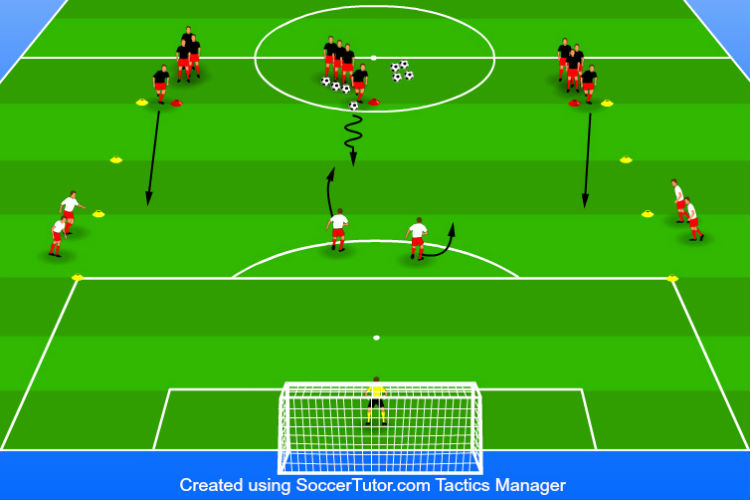
Instructions:
- To start, the attacker in the middle, starts dribbling towards goal while the other two attackers move forward on each side. The three attackers are free to dribble, pass, and move in any way to beat the defenders and score.
- Once the attackers start moving, the goalkeeper and defenders work together to prevent the attackers from scoring, or creating a quality chance on goal. Defenders are free to tackle and block attackers when possible.
- The turn is over when the attackers score, the defenders win the ball, or the ball goes out-of-bounds for any reason.
- As soon as the turn is over, the two defenders and three attackers quickly run off the field while two new defenders run on. Once the two new defenders are set, the next three attackers start their attempt to score.
- The activity continues until the round is over. After each round, collect any lost soccer balls, and select six new defenders before beginning the next round.
- Complete 3-4 rounds of 4-6 minutes.
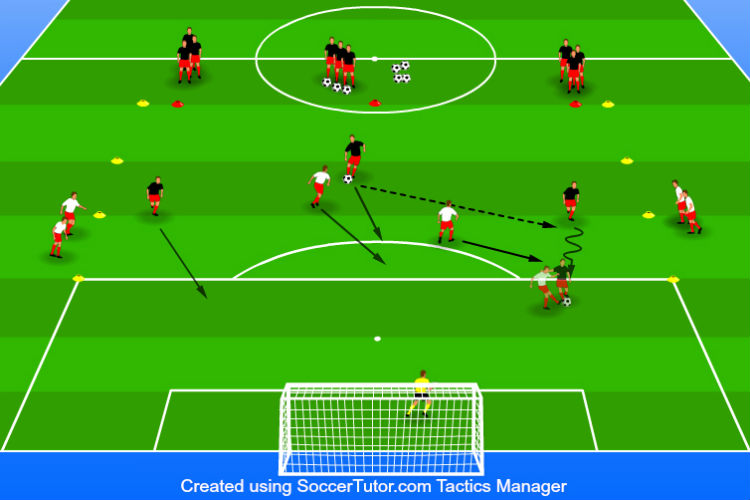
Variations:
Width and Length – Depending on the players’ age and skill level, increase, or decrease, the boundaries to allow for more, or less, space to attack and defend.
4-on-3 – Change the situation by adding one more attacker and defender. Adjust the width of the boundaries to allow for the new players.
Coaching Points:
- Educate the defenders to work together and eliminate the third player by using good body positioning to cut off passing angles. Forcing the player on the ball towards the other defending and cutting off passing angles to the third player allows the defenders to player 2-on-2.
- Teach the defenders to close down space when a pass is made.
- Remind the defenders to maintain balance and proper footwork to prevent the attackers from pushing the ball past them easily. Defenders should not reach for the ball, but rather time their tackles to be sure they will win the ball.
- Demand that the goalkeepers talk to their defenders and give them defensive instructions.
- Challenge the attackers to make it as difficult on the defenders as possible. Attackers should run at the defenders at pace and be decisive with their decisions and moves.
3. 4-on-2 Overload
How the Drill Works:
Two defenders attempt to prevent four attackers from scoring within the final third of the field. Defenders continuously defend for a given time while attackers try to score as many goals as possible.
Purpose:
Develops defensive work rate and commitment. Defenders improve their defensive speed, footwork, communication, and their ability to close down attackers. Defenders “over-train” in this activity because the likeliness of 4-on-2 in a game is slim, but the activity will better prepare them for 3-on-2s and 2-on-2s in games. Attackers work on their finishing, dribbling, passing, and decision-making as well in this activity.
Setup:
- One full-sized goal is needed.
- Use four cones to mark the playing area, about 25x25 yards.
- Choose four players to start as the attackers and two players to start as the defenders. Assign colored jerseys to each team. Extra players should rest outside of the playing area.
- Depending on the number of players present, set up another game so players will not have to sit as long in between turns. 12 players per game is the maximum.
- All the soccer balls start with the coach at the top of the playing area.
- Decide on the time for each round, and the number of rounds to be completed. Six rounds of 1-2 minutes is a good reference.
- Four attackers and two defenders start inside the playing area.
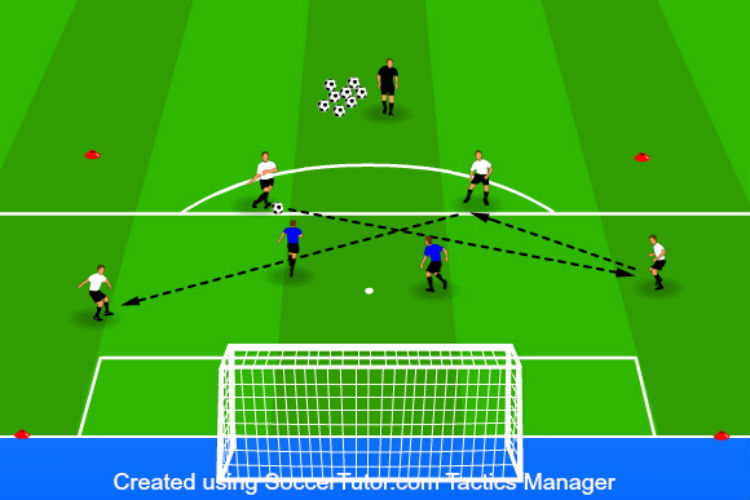
Instructions:
- To start the activity, the coach passes in a ball to one of the four attackers. The attackers pass and dribble around the two defenders attempting to shoot and score on goal.
- The two defenders work together and attempt to block, or intercept, the soccer ball from the attackers.
- If the defenders win the soccer ball from the attackers, they pass the ball out-of-bounds and the coach passes in the next ball to the attackers.
- If the attackers score, or the ball goes out-of-bounds for any reason, the coach plays the next ball in to the attackers.
- Each goal that is scored is a point for the attackers. Each time the defenders intercept the ball, or the attackers miss the goal, one point is deducted from the attackers score.
- Continue the activity for the remainder of the round. At the end of the round, gather all the soccer balls and reset them at the top of the playing area. Players rest for 1-2 minutes before switching roles. Rotate roles and players so that players play both positions.
- Repeat for as many rounds as needed.
Variations:
Goalkeeper – Add a goalkeeper to make it more difficult for the attackers to score.
Add another defender – If the attackers are scoring too easily, add another defender.
Subtract an attacker – If the defenders are struggling to prevent the attackers from scoring, subtract an attacker to make it closer.
Offsides – To make the activity more game-like, use the offsides rule for the attackers. This will change the game for both the attackers and defenders.
Change the numbers – Depending on the number of players present, switch up the number of players on each team (5-on-3, 5-on-4, 6-on-4, etc.)
Coaching Points:
- There is no goalkeeper in the activity for a reason. This forces the defenders to close down the attackers and not allow for easy shots on goal. Encourage the defenders to work as hard as they can during the full time.
- Teach the defenders to work together and communicate with each other. Defenders should help cover for one another while also being close enough to the next player when the ball is passed.
- Educate the defenders to time their tackles appropriately. Defenders should not be reaching or diving in for the ball when the time does not call for it. Defenders should constantly move their feet and stay on balance to react to the attackers. Sliding should be a last resort.
- Challenge the attackers to move the ball quickly and score as often as possible. The attackers should make the game difficult for the defenders and be creative on the ball.
4. Box Defending
How the Drill Works:
Two defenders attempt to clear crosses into the box for three incoming attackers. The defenders immediately push out of the penalty box after clearing each ball before dropping back in to the box for the next cross.
Purpose:
Develops defenders’ ability to win headers in the box and clear the ball to safety. Defenders improve their marking and willingness to win the ball. Defenders’ timing, positioning, and awareness also improve. Attackers work on their crosses and finishing in the box.
Setup:
- One full-size goal is needed.
- The activity can be done with, or without, a goalkeeper. No goalkeeper makes it more difficult for the defenders while adding a goalkeeper makes it tougher for the attackers.
- Place three cones 5 yards outside the penalty area. There should 6 yards of space between each cone.
- Select two players to start as the defenders and assign them a jersey color to wear. The defenders start at the top of the penalty box line.
- Have at least three players on each wing, outside the penalty box, be the crossers.
- Have the rest of the players form a line behind each cone above the penalty box.
- Divide all the soccer balls between the two groups of crossers.
- One player from each line goes at a time.
- Each crosser starts with a ball at their feet. Decide which crosser will serve first and then it alternates from there on out.
- Decide the time limit the defenders will work for. 1-2 minutes is suggested.
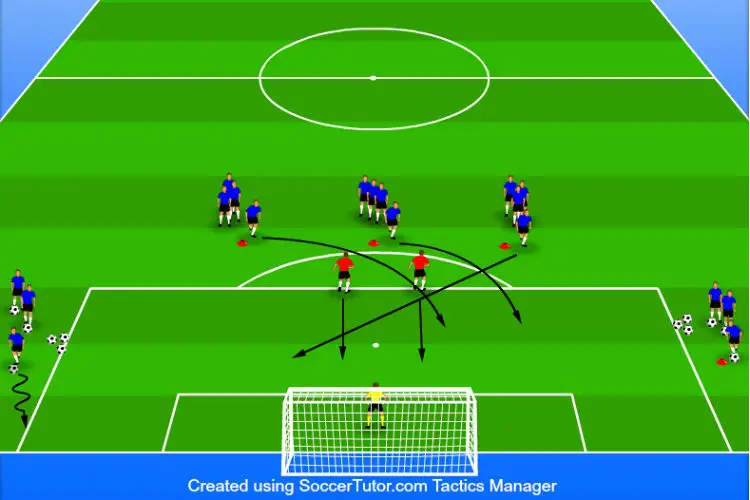
Instructions:
- The defenders start at the top of the box line and wait for the crosser to take a touch towards the end line. As soon as the crosser takes a touch, one attacker from each line begins to make their run into the box while the defenders backpedal into the box.
- The crosser can dribble all the way to the end line, or serve the ball into the box on their second touch. The crossers should try to serve the ball in the air, but are free to play it on the ground if they feel they can catch the defenders cheating.
- Once the ball is served, the defenders attempt to arrive at the ball first and prevent the attackers from scoring, or getting a free shot attempt on goal.
- Immediately after clearing the ball away from danger, the defenders run up to the penalty box line to repeat the process.
- The crosser on the opposite side of the first server must wait until both defenders are on the penalty box line before they take their first touch towards the end line. The next three attackers in line then begin their turn once the crosser takes a touch.
- The process continues this way for the remainder round (1-2 minutes). Crosses alternate sides and attackers return to the back of a line after each turn. Attackers are free to switch between attacking lines as long as there are players in each line.
- At the end of each round, select two new defenders, collect any lost soccer balls, and rotate serves as needed.
- Repeat for as many rounds as needed.
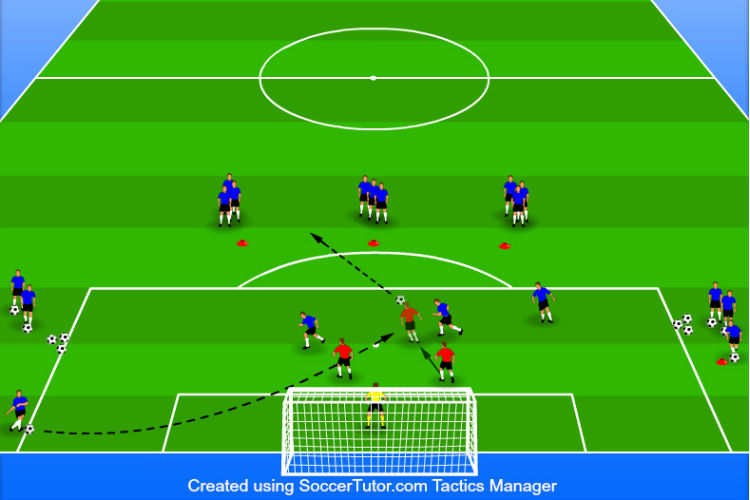
Variations:
Competition – Create a competition. Count the number of goals the defenders give up. The defender pair with the lowest number is the winning team.
Number of attackers – Increase, or decrease the number of attackers to make it more, or less, difficult on the defenders.
Number of defenders – Increase, or decrease, the number of defenders to make it more, or less, difficult on the defenders.
Crosses – Switch up the crossing angle and the number of touches before crossing to give the defenders, and attackers, more variety.
Coaching Points:
- Instruct the defenders to keep their hips open to the field so that they can see incoming attackers and beat them to the ball. Defenders should be constantly away of the ball and the attackers to give themselves the best chance of winning the ball.
- Educate the defenders to time their headers to be the first on the ball.
- Defenders positioning should be one that they are able to take at least one step towards the approaching ball and attack it to redirect it away from the attackers.
- Remind the defenders they must immediately step up to the penalty box line after each clearance, or goal, to build good habits of quickly moving on to the next play.
- Motivate the defenders to continuously work and focus on clearing the ball each time. This is a tough activity for the defenders and requires total focus. Defenders should not take a play off and let the attackers score easily.
- Challenge the crossers for consistent services into dangerous areas in the box.
- Teach the attackers to time their runs so that they can attack the cross and redirect it into the goal. The attackers should figure out who is running near post, middle, and back post.
5. Channel the Attacker
How the Drill Works:
One player defends one attacker who attempts to beat the defender and dribble through one of the three gates behind the defender. Each gate is worth a certain amount of points with the gate closest to the attacker being worth the least amount. Defenders attempt to win the ball, or prevent the attacker from dribbling through the gates worth the most points.
Purpose:
Competitive 1-on-1 activity that focuses on individual defending, closing down speed, and defensive footwork. Attacking players improve their ability to beat a defender on the dribble.
Setup:
- Use four cones to make three gates. Each gate should be in the same line; use a line on the field for reference if needed. The first gate should be 5 yards wide with the second being 4 yards wide and the last gate being 3 yards wide. See diagram for a better visual.
- Place one cone 15-20 yards away from the largest gate. The cone should be perpendicular to the first cone used for the largest gate. See diagram for more information.
- Divide the players into two teams and assign each team a jersey color.
- Assign one team to start has the attacking team and have them form a line behind the cone set up 15-20 yards away from the largest gate.
- Assign the other team to start as the defending team and have them form a line behind the smallest gate.
- Each defender should have a ball at their feet. Keep any extra soccer balls around the defending team’s line.
- If there are more than 12 players in this activity, set up another game so that there is about 6-10 players per game.
- Decide on a time limit and number of rounds for this activity. 3-4 minutes of 4-6 rounds is a good reference.
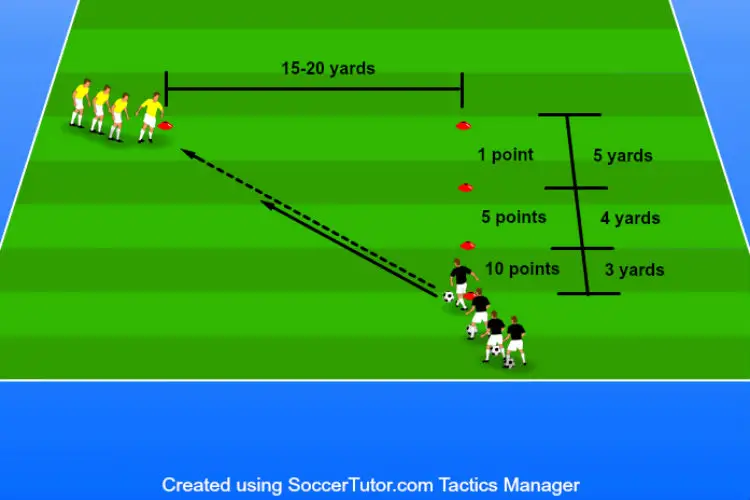
Instructions:
- The first defender in line starts the activity with a pass to the first attacker in line. As soon as the defender passes the ball they sprint towards the attacker.
- The attacker receives the ball and dribbles towards the gates.
- The attacker attempts to score the most points possible, or available. The furthest away gate is worth 10 points, the middle gate is worth 5, and the closest gate is worth 1 point.
- The defender attempts to channel, or direct, the defender away from the 10-point gate and towards the 1-point gate. If possible, the defender attempts to win the ball and prevent the attacker from getting any points.
- As soon as the attacker dribbles through a gate, or the defender wins the ball, the next two players immediately begin their turn.
- The coach keeps track of the points scored for the attacking team for each round.
- At the end of each round, the teams collect and lost soccer balls, and then switch lines so that the defending team now becomes the attacking team.
- After each team has attacked once, the coach declares the attacking team with the most points the winner.
- The next two rounds begin back at zero points for both teams and teams repeat the process for another 2-4 rounds.
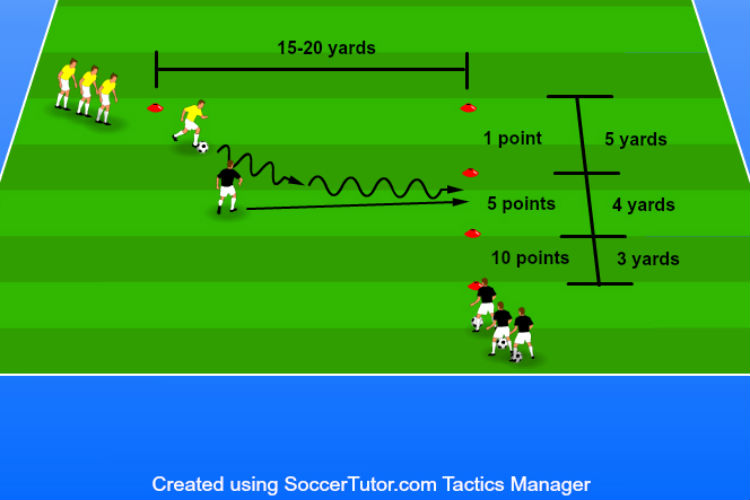
Variations:
Defending Team Can Score – If the defender wins the ball from the offensive player, they are free to attempt score on any of the gates for points. This develops players’ ability to quickly react when they lose the ball and prevent the other team from progressing.
Coaching Points:
- Clearly explain the scoring system and the purpose of channeling a defender away from the higher point gates. Give some advice to younger players before the first round. For older players, give them a round or two to see if they can figure it out on their own. Players should not be given the answers at the beginning otherwise they will not develop the problem-solving abilities players need.
- Channeling a defender is effective when forcing a player away from goal, towards team pressure, or towards the sideline. Other examples include forcing a player to use their weaker foot, or to stop a counter-attack.
- Defenders should sprint towards the attacker to close down the space the attacker has to dribble into. Defenders should shorten their steps as they get closer to the attacker to prevent getting beat. Once close enough, defenders should move backwards at the same pace the attacker is moving forwards and force the attacker towards the 1-point gate. The defenders should time their tackles when they are close enough to win the ball.
- Defenders need to get close enough to the attackers to force them to put their headers down and lose vision of the field.
- When directing, or channeling, a player, defenders should position their bodies sideways at a 45-degree angle and encourage the attackers to dribble into the space defenders are leaving open.
- Challenge the attackers to be decisive, quick, and creative on the ball. Attackers should attempt to beat the defenders and score as many points as possible.
6. Defend the Gate
How the Drill Works:
One defender passes the ball across the grid to one attacker and then immediately closes them down to defend while the attacker attempts to dribble through the gate in the middle of the grid.
Purpose:
Competitive 1-on-1 activity that develops defensive footwork, timing, and positioning. Offensive dribbling, 1-on-1 moves, and ball control is also improved.
Setup:
- Use four cones to set up a playing grid, about 20-25 yards long by 10-12 yards wide.
- Place two poles, or cones, in the middle of the grid.
- Divide the players into two groups and have each group form a line on each end line of the playing grid. If there are more than 5 players per group, set up another playing grid next to the first one to allow for player repetitions.
- Assign one group as the offensive team, and the group on the opposite end line as the defensive team.
- Each defensive team player should have one soccer ball.
- Decide on the number of rounds and the time for each round. At least two rounds of 6-8 minutes is suggested.
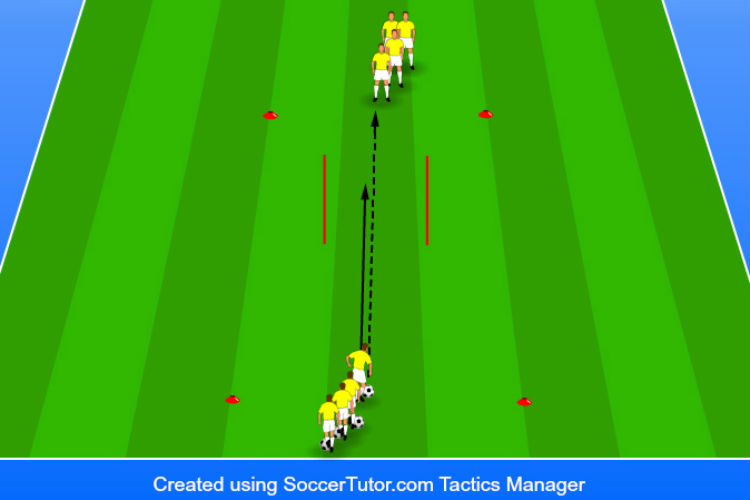
Instructions:
- The first defender in line starts the activity by passing the ball through the gate, and across the grid to the first attacker in line.
- As the ball is traveling, the defender runs towards the attacker, quickly closing down the space.
- The attacker receives the ball and attempts to dribble through the gate in the middle of the grid.
- The defender attempts to prevent the attacker from dribbling through the gate while also trying to win the ball, or force the ball out-of-bounds.
- The turn is over when the attacker dribbles through the gate, the defender wins the ball, or the ball goes out-of-bounds for any reason. The turn is also over if after 30 seconds the attacker is unable to dribble through the gate.
- After each turn, players switch lines, and the next turn immediately begins.
- The activity continues for the remainder of the round. Give tips and tricks to the players in between rounds while they rest before starting the next round. Play at least 2 rounds of 6-8 minutes.
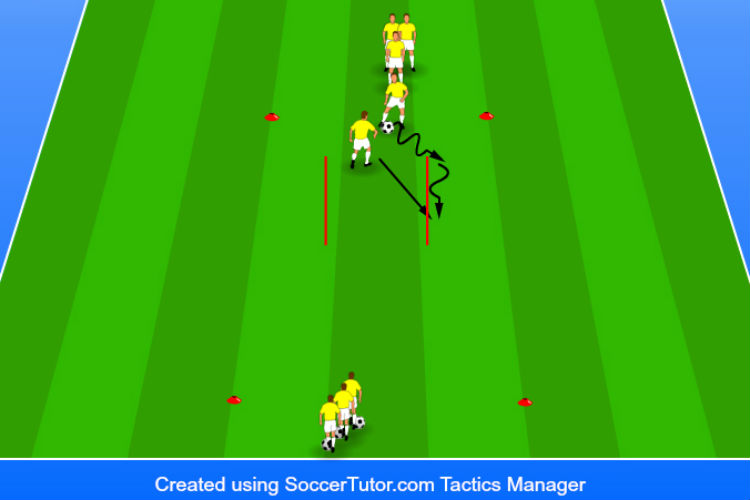
Variations:
Vary the grid dimensions – Depending on the players’ age and skill level, increase the size of the grid to give the attackers more space making it more difficult for the defenders.
Coaching Points:
- Educate the players on proper defensive positioning and footwork. Defenders should quickly close down the attackers, but as defenders get closer they should bend their knees and take smaller steps to react quickly to the attacker’s movements. Defenders should turn at a 45-degree angle and attempt to push the attacker away from the gate, towards the sidelines.
- Teach the defenders to keep moving backwards as the attacker moves forward, keeping a good distance between them until an opportunity to win the ball presents itself.
- Explain that defenders need to get close enough to the attackers to force them to put their heads down and lose vision of the field and their options.
- Remind the players to time their tackles properly so they are sure to win them. Players should not reach for the ball and be caught off-balance to allow attackers to get past them. Players should slide-tackle as a last resort.
- Challenge the players to be creative on offense and attack the defender with confidence!
- Encourage players to focus on their first touch and to use quick moves and fakes to get past the defenders.
7. Defensive Recovery Runs
How the Drill Works:
One defender competes against one attacker to make a recovery run back towards their goal with an attacker attempting to beat them to the ball and score. Defenders must clear the ball, or prevent the attacker from scoring on goal.
Purpose:
Defenders work on a game-like situation when the opposing team kicks a long ball, over their heads, to their striker for a chance on goal. Defenders develop their recovery run speed, footwork, and awareness while preventing the attacker from a clear chance on goal. Attacking players work on their speed, finishing, and their ability to get around a defender.
Setup:
- One full-size goal is needed on the end line.
- One goalkeeper is preferred for this activity to make the situation more game-like. If there are extra goalkeepers, have them rotate in every 2-4 repetitions.
- Place two cones 5-8 yards inside the half-line that the goal is on. The cones should be parallel to the end lines and be outside the center-circle with 5-10 yards between them. See pictures for more information.
- Divide the players into two, evenly numbered groups.
- Have each group form a separate line behind the two cones. The group closest to the inside of the field will start as the defenders while the other group starts as the attackers.
- The coach, or extra player, is positioned inside the center-circle just to the inside of the lines.
- All the soccer balls are placed inside the center-circle with the coach.
- Decide on the time limit and number of rounds. Two rounds of 7-10 minutes is a reference.
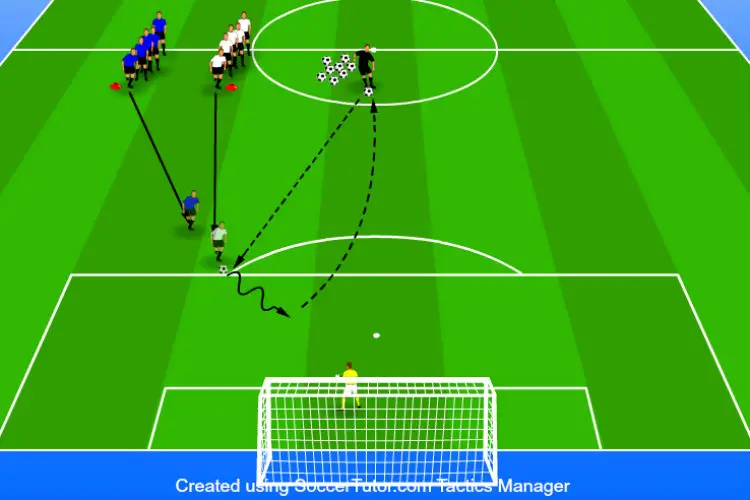
Instructions:
- The coach starts the activity by kicking, or throwing, a soccer ball towards the penalty box in front of the players.
- The first players in each line take off sprinting towards the ball attempting to get their first.
- Given that the defensive line is closer to the ball than the offensive line, the defenders should get to the ball just ahead of the attackers and attempt to turn and play the ball back to the coach. If a turn cannot be successfully completed, the defender should clear the ball out-of-bounds or pass the ball back to the goalkeeper for them to kick the ball up the field.
- The attacker should attempt to beat the defender to the ball using their speed and elusiveness for a chance to score on goal. If the attacker gets to the ball first, the defender attempts to block the attacker’s shot.
- If the attacker does not beat the defender to the ball, they should attempt to block, or intercept, the ball from the defender as they attempt to play it out of danger.
- After completing their turn, the players return to the back of their lines and the next two players immediately begin their turn.
- The activity continues for the remainder of the round. At the end of the round, collect any lost soccer balls and give the players a short break while they switch lines. Defenders become attackers while attackers become defenders.
- Complete at least two rounds of 7-10 minutes. If more than two rounds are going to completed, switch sides of the field after two rounds so that defenders and attackers go from the other wing.
Variations:
Change sides – Halfway through the drill, change sides to have players work on the opposite side of the field.
Player services – Instead of a coach, or extra player, standing and kicking the ball from the center-circle, have a player hit game-like long balls from behind half. The player should attempt to drop the ball 10 yards in front of the penalty area.
Defenders face forward – Make it more difficult for the defenders by making them face their opponent’s goal on the start. Defenders improve their footwork and turning ability before they can take off sprinting. Adjust the attackers cone as needed to still give a slight edge to the defenders.
Type of service – Vary the type of ball players are running down (i.e. on the ground, in the air, bouncing, etc.)
Coaching Points:
- Teach the defenders to be aware of their positioning to the attacker behind them as they chase down the ball. Defenders need to be aware of the attacker to make a good game decision for their team. If defenders have time, they should turn and pick out a pass back to the coach, or turn and dribble up field, keeping possession for their team. If defenders do not have time, or space, they should clear the ball out-of-bounds, or pass it back to their goalkeeper for them to kick.
- Remind the defenders to limit risk when making their decision. Of course, defenders should attempt to keep possession of the ball for their team when possible, but make sure defenders are not taking too much risk and putting their team at risk for giving up a goal. Clearing the ball out-of-bounds is a fine choice.
- Challenge the attackers to be quick and elusive when trying to beat the defender in front of them. The attackers should make it as difficult as they can for the defender to keep possession of the ball.
8. Horizontal Challenge
How the Drill Works:
One attacker attempts to dribble across the top of the penalty box with one defender between them and the goal. The defender tries to intercept the ball, or block the attacker’s shot attempt. The attacker is free to change pace and direction along the penalty box line.
Purpose:
Develops defensive footwork, agility, and timing when an attacker is cutting inside to create a better scoring chance. Defenders improve their ability to stay between the attacker and the goal to prevent quality goal scoring attempts. Offensive players increase their ability to beat a defender on their inside shoulder and score.
Setup:
- One full-sized goal is needed on the end line.
- One goalkeeper is suggested for this activity to make it more game-like. If no goalkeeper is present the activity can still be completed. Extra goalkeepers should stand off to the side of the goal and rotate in every 2-3 repetitions.
- Set up two cones just outside the top of the penalty box on one side of the field. The cones should be parallel to the sidelines and should have 3-4 yards of space between them. See diagram for more information.
- Divide the players into two groups.
- Assign one group as the defensive group and have them form a line behind the cone closest to the goal.
- Assign the other group as the offensive group and have them form a line behind the cone furthest away from the goal.
- All the soccer balls should be with the offensive group.
- The first player in the offensive line starts with a ball at their feet.
- Decide on the number of rounds and the time for each round. At least two rounds of 6-8 minutes is suggested.
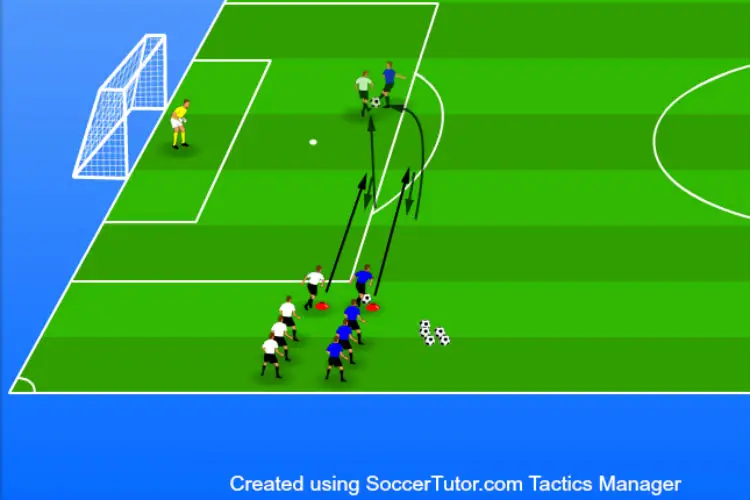
Instructions:
- The first player in the offensive line begins the activity by dribbling along the top of the penalty box line.
- At the same time the attacker starts dribbling, the first defender in line moves alongside of the attacker attempting to intercept, or prevent them from scoring on goal. The defender attempts to stay between the attacker and the goal at all times.
- The offensive player attempts to get past the defender by changing speeds, direction, and positioning to score on goal. The attacker is free to use whatever moves they want, but must stay close (3-4 yards) to the penalty box line and move parallel to the line.
- The defender is free to tackle, channel, or block the attacker at any point.
- The turn is over when the defender wins the ball, blocks the shot, or the attacker scores. The next two players immediately begin their turn once the players in front of them have finished.
- The players return to the back of their lines and the process continue for the remainder of the round. After the time limit, collect any lost soccer balls, and then have the players switch lines. Play for as many rounds as needed.
Variations:
Change field sides – Switch sides of the field so players work on defending and scoring from both sides.
Coaching Points:
- Instruct the defenders to maintain good positioning between the goal and the attacker. The defenders should constantly move their feet and adjust their position to prevent the attacker from getting inside of them.
- Teach the defenders to be tight enough to the attackers that they can block, or intercept the ball from them when possible.
- Remind the defenders to bend their knees and stay on their toes to react quickly to the attackers’ change of speed and direction.
- Challenge the attackers to be creative and decisive. Attackers should want to score every turn and make it difficult for the defenders.
- Encourage the goalkeepers to stay with their communication and light on their feet, always ready for a shot.
9. No Turn 1-on-1
How the Drill Works:
One defender attempts to keep one attacker from turning and scoring on goal.
Purpose:
Develops a defender’s ability to keep an attacker from turning them and scoring. Defenders improve their positioning, footwork, and strength. Attackers become more comfortable with their back to goal and their ability to turn and shoot.
Setup:
- On full-sized goal is needed.
- One goalkeeper is suggested to make the activity more game-like. If no goalkeepers are present, the activity can be completed without one.
- Depending on the number of players present, use multiple goals for this activity to increase the number of repetitions players get. Best if no more than 10 players are at each goal.
- Set up a 12x12 yard box in front of goal. The box should start eight yards out from goal. See diagram for more information.
- Have two players start inside the box. One player is the defender and one player is the attacker.
- The rest of the players form a line 6-8 yards behind the box with all the soccer balls.
- The first player in line starts with a ball at their feet.
- Decide on the number of rounds and the time for each round. At least 3 rounds of 5-7 minutes is suggested.
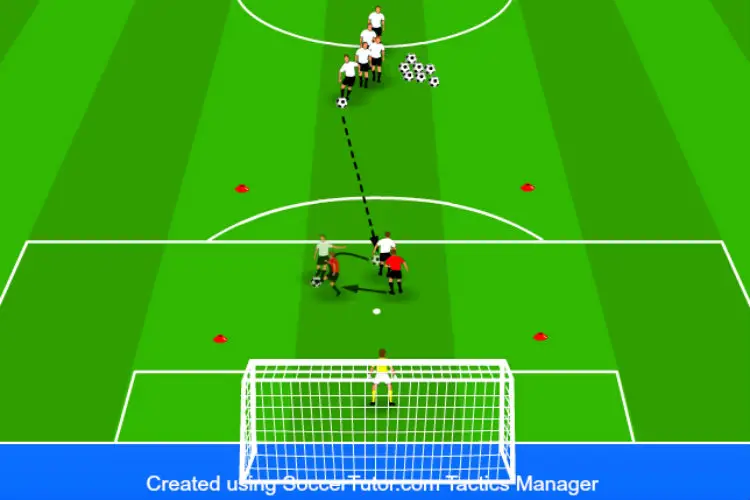
Instructions:
- To start the activity, the first player in line passes the ball to the attacker inside the box.
- The attacker receives the ball with their back to goal while the defender applies pressure on their back.
- The attacker attempts to turn and score on the defender while staying inside the box.
- The defender attempts to intercept the ball, block the attacker’s shot, or force the attacker outside of the box.
- The turn is finished when the attacker scores, loses the ball, or is forced out of the box.
- After the turn, the defender becomes the attacker, the passer becomes the new defender, and the attacker retrieves their ball and returns to the back of their line. The next turn begins as soon as the new defender and attacker are set.
- Continue the process for the remainder of the activity.
Variations:
Defender outside the box – Have an extra defender outside of the box that is free to defend the attacker if they dribble outside the box. This allows for the attacker to continue playing if they dribble outside the box, but makes it more difficult if they. The extra defender must move outside of the box until the attacker breaks the line. The attacker can try to be elusive and get both defenders on one side before exploding to outside of the box on the other side and attempting to score.
Box placement – Change the box placement in front of the goal. Move the box left, or right, to create a different attacking and defending angle.
Box size – Increase, or decrease, the box size depending on the players and how the activity is going.
No box – No box makes it more difficult for the defenders since there is no boundaries. No boundaries mean the turn is over only when the defender wins the ball, or the attacker shoots.
Coaching Points:
- Let the defenders know the box is there because in a game the defenders will most likely have help to either side of them if the attacker dribbles that far away. Anytime defenders can force their attacker towards more defensive help is a good thing. The box also ensures that players are not dribbling all over the place and taking a long time to shoot. Change up the box as needed.
- Instruct the defenders to maintain good body positioning between the goal and the attacker. They should constantly adjust their position with light, quick feet.
- Remind the defenders to get tight enough to the attacker that they cannot turn, but not too close that the attacker rolls off their shoulder and turns. Defenders should never be square to the attacker; always sideways.
- Challenge the attackers to be strong and elusive with their decisions. Attackers should keep their bodies between the ball and the defender and use strong, quick body fakes to turn.
- If positions are already determined within the team, then have the defenders defend, and the offensive players work with their back to goal. Switching roles is not necessary.
10. Defense Waves
How the Drill Works:
The team splits into groups of three. Each team takes a turn being the defensive group. The defensive team tries to prevent the first attacking group from scoring for 15 seconds. Then, they repeat the drill with the next team of attackers, and so on, until they’ve defended five times in a row.
Purpose:
This drill works on all aspects of defending as a group, including communication, moving as a unit, and tackling. Plus, the continuous wave aspect means the players must get used to defending when they’re tired.
Setup:
Use the penalty box for this drill. If you don’t have access to one, set up an 18-yard box using cones.
Set up a full-size goal if you have a goalkeeper. If you don’t, use a mini goal or create a small goal with cones.
Split your team into groups of three.
One team is designated as the defensive team and takes position inside the box.
The others line up outside the penalty box with the ball.

Instructions:
The defensive team gets into position inside the box and the first attacking group awaits the signal on the edge of the box.
On the coach’s whistle, the attack vs defense game begins.
The attacking team only has 15 seconds to score. They can pass, dribble, and shoot however they wish.
Attackers may not score from outside the box.
The attacking wave is over if there’s a goal, the defense turns over possession, or the 15 seconds elapse.
Once the round is over, the defense gets five seconds to reorganize before the next group attacks.
Each group sustains five consecutive waves before changing with another group.
Variations:
No time limit - Get rid of the time limit and run the drill until there’s a goal or turnover.
Maximum touch rule - Introduce a maximum touch rule for attackers, such as two or three touches, before they must make a pass.
Minimum pass rule - Attackers must make a minimum number of passes before they can score.
Adjust the numbers - This drill can be easily adapted to groups of various sizes (e.g. 2v2, 4v4, 4v3, etc.)
Coaching points:
Defense is the priority so pay attention to how the defenders perform before you focus on the attackers.
Encourage the defensive groups to communicate non-stop and work as a unit to shut down the opposition.
Look out for good defensive habits, like defenders staying on their feet, anticipating movements, covering one another, and jockeying.
Correct players making obvious errors, such as lunging into tackles, going to ground easily, or ball-watching.
11. Two-Phase Defense
How the Drill Works:
In the first phase, two defenders try to win the ball from a team of four attackers inside a possession box. If they’re unsuccessful, the attackers move into the second phase (inside the penalty box) and try to score against the other two teams.
Purpose:
This drill allows players to practice in two different defensive scenarios while being outnumbered. These situations happen frequently in games.
Setup:
Use the penalty box and the space outside it to run this drill.
Set up a full-size goal if you have a goalkeeper. If not, use a mini goal or cones.
Create a 10-yard cone grid outside the box to use as the possession zone.
Divide the players into teams of four.
One team starts in defense, with two defenders inside the possession zone, and the other two inside the penalty box.
All four attackers start inside the possession zone with the ball.

Instructions:
On the coach’s signal, the drill starts as the attackers in the possession zone attempt to make five consecutive passes.
The two defenders attempt to dispossess them.
If the defenders win the ball, the defenders and attackers switch roles, and the drill restarts.
When a team makes five consecutive passes, the defenders inside the possession zone stop.
The attackers then move into the penalty box for the second phase.
Once inside the box, the attackers try to score however they can.
The two defenders try to stop them.
The round is over if there’s a goal, the defensive team wins possession, or the ball goes outside the box.
The defensive team then joins the back of the attacking line and the attackers become the next defenders.
Variations:
Change passing targets - Change the consecutive passing targets in phase one according to the performances of your players.
More defenders - Add extra defenders if the drill is too difficult as a 4v2.
Competition - Create a competition to see which team concedes the least number of goals.
Coaching points:
Since the defenders will be outnumbered, ensure that they communicate and work as a team to stop the attackers.
Defenders will have to work hard and be aggressive to win the ball when they’re outnumbered.
Give players feedback based on what you’re seeing, helping them learn how to deal with these situations.
Although attack is secondary in this drill, encourage the players with the ball to be decisive and clinical.

